Source: Pontem Network; Compiled by: Tao Zhu, Golden Finance
This article will introduce the details and methods of the first airdrop of LSD to Liquidswap protocol users.
Allocation:
The first LSD airdrop will account for 5% of the total token supply, of which 69% will be liquid at the time of the Token Generation Event (TGE), and the rest will be linearly vested over 4 months, released monthly. Another 10% will be provided over time in the form of staking rewards and future airdrops. Tokens can be claimed at claim.liquidswap.com
The airdrop will be distributed according to the following categories:
27% allocated to community NFTs, meme tokens, product testers and ambassadors as of snapshot date July 10, 2024;
49% allocated to early adopters: trading and liquidity added to Liquidswap before snapshot date April 7, 2024;
24% allocated to late users: trading and liquidity added to Liquidswap between snapshot date April 7, 2024 and snapshot date July 10, 2024.
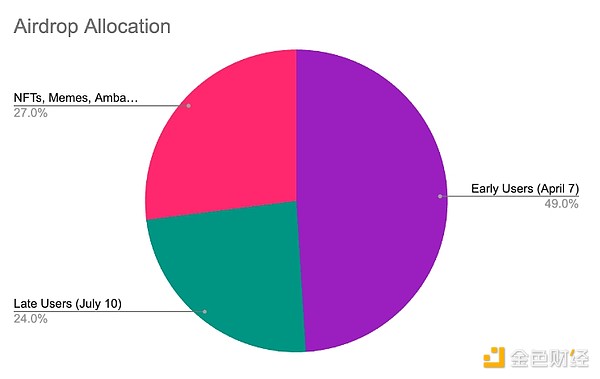
Confirmed community members can receive the following rewards:
In the airdrop calculation, the transaction volume and liquidity counts of early and late users will apply a reward multiplier to provide more rewards to key parts of the community.
The following volume and liquidity multipliers apply to these categories:
10% goes to NFT and meme holders
20% goes to X verified followers of @Pontem and LumioFDN
10% goes to Lumio whitelisted addresses
For example, if you traded $100 and your total bonus multiplier is 10% + 20%, your volume for the April and July snapshots would count as $130.
Whales are excluded from the bonus to benefit smaller users (max cost = $500).
Methodology:
Cost ratio, bot mitigation, wallet max, and allocation to mid-tier users.
Cost Scale:
Individual airdrop allocations use a cost scale associated with each category to determine a relatively fair cost scale for each account (assuming token prices at launch).
The following costs are used for each category:
Trading Volume:The cost for trading volume is 0.2% - an approximation of the average trading fees for non-correlated and correlated assets. For example, if a user trades $100, the cost is $0.20
Time-weighted Liquidity Increase:The cost of 15% of allocated capital over a year. For example, if a user allocated $100 of liquidity for 365 days, the cost would be $15
Pirate NFT:90 APT at $6.86 APT
Dark Ages NFT:58 APT at $6.86 APT
Doodoo NFT:21 APT at $6.86 APT
Doodoo meme coin:$0.54
ReTURD meme coin:$6.33
Product Tester Level 1:$1000
Product Tester 2
Product Tester Level 3: $250
Ambassador Level 1: $1000
Ambassador Level 2: $500
Ambassador Level 3: $200
Use the following base cost scale for each category:
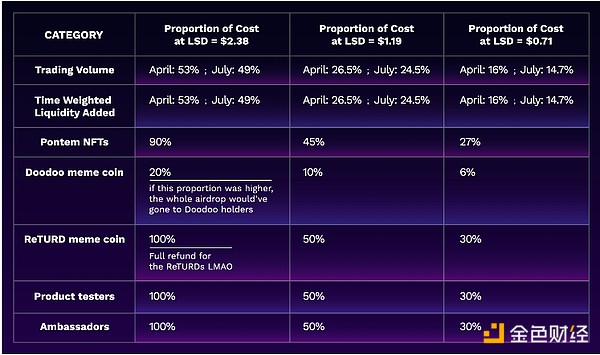
Bot Mitigation:
A cost ratio is used so that even if bots are included in the airdrop, they will receive rewards in proportion to their cost. For example, if a bot spent $100 in their account and a human spent $100, they will receive the same amount in the airdrop. Bots are people too. The rewards are proportional to the cost and value received by Liquidswap, so no one loses money using this method.
As a standard sybil detection measure, a minimum threshold of 5 trades, $250 in volume, or $100 in 1 year of added liquidity is used to remove bot addresses that spam the protocol. Any address that receives less than 1 LSD will also be removed. This leaves 57,000 wallets considered for the airdrop. It is generally believed that the tendency of bots is to spam low-cost addresses to get the lowest airdrop allocations.
It is still possible that there are bot accounts above these thresholds, so a larger proportion of the final cost is allocated to categories that are less likely to have bots: mid-tier users and users who qualify for the reward category.
We also specifically removed some addresses that were company-affiliated accounts or partner accounts.
Wallet Caps and Reallocation to Mid-tiers
After running multiple simulations at the maximum allocation, we settled on a cap of 8,400 LSD. This cap allows us to provide appropriate rewards to a large portion of the community while also acknowledging the large volume and liquidity generated on our application by a small number of people. The maximum amount a wallet can receive is capped at 8,400 LSD tokens.
All tokens above the maximum are reallocated to all wallets below the whale maximum cap. We assume that these are the most valuable users who do not exceed the whale cap. This reallocation range was chosen based on the assumption that the most valuable users belong to this "middle class" of users.
The reallocation to "middle class" users is allocated according to a standard polynomial curve to allocate less to smaller users where bot allocations are likely to be higher, and less to large cost users where the reallocation has less impact on the cost ratio.
Below is a view of the distribution for each of the 57,000 wallets in the reallocation range.

Referrals:
The referral bonus is 10% of the referred user's trading volume and increased liquidity. This means that if you refer a user and they trade $100, you will receive $10 for your own account.
Users can continue to share their referral links to receive future rewards and airdrop calculations.
Analysis:
The funds and bonuses allocated to the community category have resulted in higher costs for these users. The chart below maps the wallet index against the allocations. The area under the curve is the sum of allocations to users. Most airdrop allocations are skewed toward large whale accounts and bots.
The shift to favor community and “mid-tier” users widened the curve, making the slope of the cumulative allocations in the wallet index less steep. This means that many smaller users received additional allocations that would otherwise have gone to whales, non-community users, or bots.
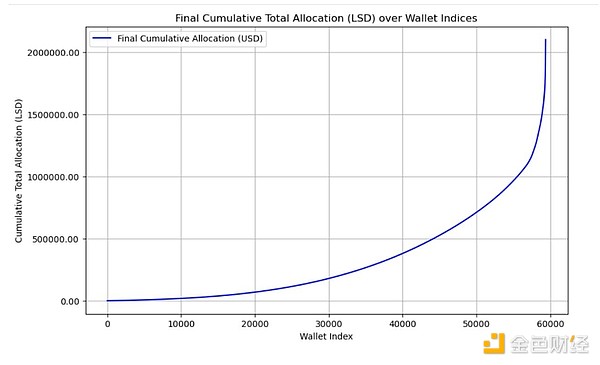
The figure below zooms in on a portion of the entire distribution. From this figure, it is clear that the colored community member groups bear a higher proportion of the costs than the gray non-community member groups.
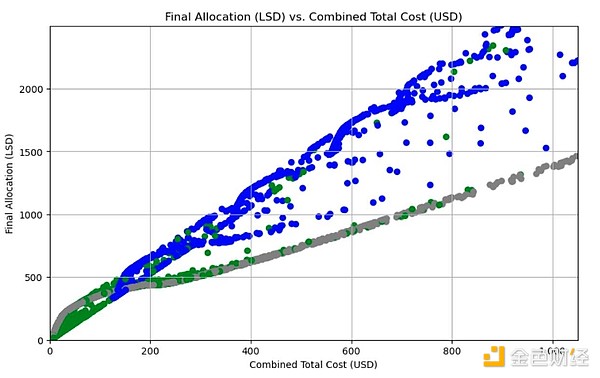
Below are the average and median proportions of costs (ROI) broken down by different categories (this list is not exhaustive).
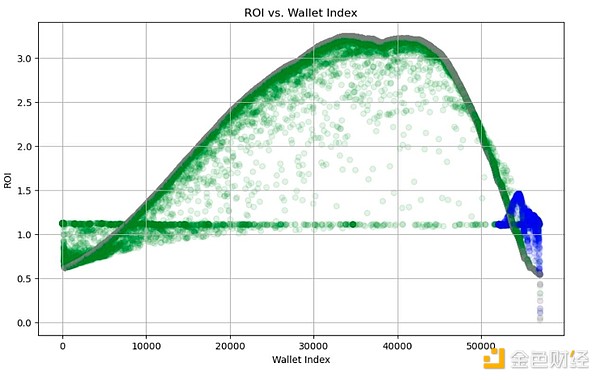
 Bitcoinist
Bitcoinist
 Bitcoinist
Bitcoinist Coinlive
Coinlive  Others
Others Tristan
Tristan Coinlive
Coinlive  Beincrypto
Beincrypto Coindesk
Coindesk Nulltx
Nulltx Cointelegraph
Cointelegraph Cointelegraph
Cointelegraph